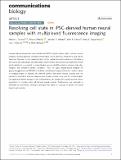| dc.contributor.author | Tomov, Martin L | |
| dc.contributor.author | O’Neil, Alison | |
| dc.contributor.author | Abbasi, Hamdah S | |
| dc.contributor.author | Cimini, Beth A | |
| dc.contributor.author | Carpenter, Anne E | |
| dc.contributor.author | Rubin, Lee L | |
| dc.contributor.author | Bathe, Mark | |
| dc.date.accessioned | 2022-01-26T16:02:47Z | |
| dc.date.available | 2021-10-25T19:01:14Z | |
| dc.date.available | 2022-01-26T16:02:47Z | |
| dc.date.issued | 2021-06 | |
| dc.date.submitted | 2021-01 | |
| dc.identifier.issn | 2399-3642 | |
| dc.identifier.uri | https://hdl.handle.net/1721.1/133113.2 | |
| dc.description.abstract | <jats:title>Abstract</jats:title><jats:p>Human induced pluripotent stem cell-derived (iPSC) neural cultures offer clinically relevant models of human diseases, including Amyotrophic Lateral Sclerosis, Alzheimer’s, and Autism Spectrum Disorder. In situ characterization of the spatial-temporal evolution of cell state in 3D culture and subsequent 2D dissociated culture models based on protein expression levels and localizations is essential to understanding neural cell differentiation, disease state phenotypes, and sample-to-sample variability. Here, we apply <jats:underline>PR</jats:underline>obe-based <jats:underline>I</jats:underline>maging for <jats:underline>S</jats:underline>equential <jats:underline>M</jats:underline>ultiplexing (PRISM) to facilitate multiplexed imaging with facile, rapid exchange of imaging probes to analyze iPSC-derived cortical and motor neuron cultures that are relevant to psychiatric and neurodegenerative disease models, using over ten protein targets. Our approach permits analysis of cell differentiation, cell composition, and functional marker expression in complex stem-cell derived neural cultures. Furthermore, our approach is amenable to automation, offering in principle the ability to scale-up to dozens of protein targets and samples.</jats:p> | en_US |
| dc.language.iso | en | |
| dc.publisher | Springer Science and Business Media LLC | en_US |
| dc.relation.isversionof | http://dx.doi.org/10.1038/s42003-021-02276-x | en_US |
| dc.rights | Creative Commons Attribution 4.0 International license | en_US |
| dc.rights.uri | https://creativecommons.org/licenses/by/4.0/ | en_US |
| dc.source | Nature | en_US |
| dc.title | Resolving cell state in iPSC-derived human neural samples with multiplexed fluorescence imaging | en_US |
| dc.type | Article | en_US |
| dc.identifier.citation | Tomov, Martin L, O’Neil, Alison, Abbasi, Hamdah S, Cimini, Beth A, Carpenter, Anne E et al. 2021. "Resolving cell state in iPSC-derived human neural samples with multiplexed fluorescence imaging." Communications Biology, 4 (1). | en_US |
| dc.contributor.department | Massachusetts Institute of Technology. Department of Biological Engineering | |
| dc.relation.journal | Communications Biology | en_US |
| dc.eprint.version | Final published version | en_US |
| dc.type.uri | http://purl.org/eprint/type/JournalArticle | en_US |
| eprint.status | http://purl.org/eprint/status/PeerReviewed | en_US |
| dc.date.updated | 2021-08-24T18:49:24Z | |
| dspace.orderedauthors | Tomov, ML; O’Neil, A; Abbasi, HS; Cimini, BA; Carpenter, AE; Rubin, LL; Bathe, M | en_US |
| dspace.date.submission | 2021-08-24T18:49:26Z | |
| mit.journal.volume | 4 | en_US |
| mit.journal.issue | 1 | en_US |
| mit.license | PUBLISHER_CC | |
| mit.metadata.status | Authority Work Needed | en_US |
